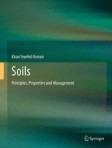Search
Search Results
-
Dioxins and Furans: Sources, Impacts and Remediation
Dioxins and furans are persistent, highly hazardous and ubiquitous compounds that have become the focus of many investigations due to the...
-
Soil Resources and Soil Degradation
The total land area of the world is estimated to be 130,575,894 km2, including rocky surfaces, deserts, ice-covered areas, and lands with soil. Only...
-
Laccase from prokaryotes: a new source for an old enzyme
Laccases (benzenediol: oxygen oxidoreductase, EC 1.10.3.2) are multi-copper-containing enzymes capable of catalyzing the oxidation of a wide range of...

-
Sustainable Solutions for Agro Processing Waste Management: An Overview
Technological revolution in the field of agriculture has tremendously increased the agriculture production. The net impact by the revolution in...
-
Biodegradation of Mono-Aromatic Hydrocarbons by Fungi
The biodegradation of organic compounds by fungal strains has been studied for several decades. Fungi have proven to be able to degrade a wide range...
-

-
Microbial Degradation of PAHs: Organisms and Environmental Compartments
Polycyclic aromatic hydrocarbons (PAHs) represent a major class of organic compounds (Xue and Warshawsky 2005), that consist of over 100 individual...
-
Marine crude-oil biodegradation: a central role for interspecies interactions
The marine environment is highly susceptible to pollution by petroleum, and so it is important to understand how microorganisms degrade hydrocarbons,...

-

-
Dyes—Environmental Impact and Remediation
Dyes are an important class of synthetic organic compounds used in many industries, especially textiles. Consequently, they have become common...
-

-
A Rapid Two-Step Bioremediation of the Anthraquinone Dye, Reactive Blue 4 by a Marine-Derived Fungus
A rapid two-step technique for bioremediation of the anthraquinone dye, the Reactive Blue 4 (RB4) by a marine-derived fungus is reported here. In the...

-
Bacterial assisted phytoremediation for enhanced degradation of highly sulfonated diazo reactive dye
PurposePhytoremediation is the exploitation of plants and their rhizospheric microorganisms for pollutants treatment like textile dyes, which are...

-
Effect of DOR Incubated with Saprobe Fungi on Hydrolytic Enzymes Activities and Chemical Properties of Rhizospheric Soil of Lettuce
The dry olive residue (DOR), a by-product of the olive mill industry, is produce in large quantities in Mediterranean countries. The phytotoxic and...
-
Decolorization of Azo, Triphenylmethane and Anthraquinone Dyes by Laccase of a Newly Isolated Armillaria sp. F022
A newly isolated white-rot fungus, Armillaria sp. strain F022, was isolated from the decayed wood in a tropical rain forest. Strain F022 was capable...

-
An investigation of anthraquinone dye biodegradation by immobilized Aspergillus flavus in fluidized bed bioreactor
PurposeBiodegradation and biodecolorization of Drimarene blue K 2 RL (anthraquinone) dye by a fungal isolate Aspergillus flavus SA2 was studied in...

-
Microbial dechlorination of chloroorganics and simultaneous decolorization of pulp–paper mill effluent by Pseudomonas putida MTCC 10510 augmentation
The physicochemical analyses of pulp–paper mill effluent revealed that it was dark brown with 1761 ± 2.3 color PtCo units having slightly alkaline...

-
Olive oil mill wastewaters before and after treatment: a critical review from the ecotoxicological point of view
The olive oil mill wastewater (OMW) is a problematic and polluting effluent which may degrade the soil and water quality, with critical negative...

-
Impact of PAH on biological health parameters of soils of an Indian refinery and adjoining agricultural area—a case study
The present study is aimed at analysing and comparing different soil enzymes in soil samples of native contaminated sites of a Mathura refinery and...
-
Decontamination of anthracene-polluted soil through white rot fungus-induced biodegradation
This study investigated the effect of inoculation of white rot fungus, Pleurotus ostreatus , incubation time, and levels of contamination on...

